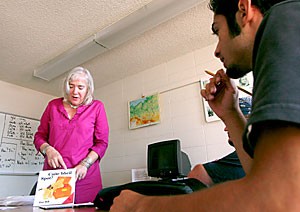Jambo, Hei, Selamat Pagi. If you are not a native speaker of Swahili, Norwegian or Indonesian, you probably did not understand that. No worries though, the UA Critical Languages department can help. The department offers less commonly taught languages to UA students. The Arizona Daily Wildcat spoke with Alex Dunkel, director of the Critical Languages program, to find out what “”critical languages”” are all about.
Wildcat: What is the history of critical language programs?
Dunkel: The term started many years ago (when) the U.S. defense and education departments sort of preempted them. Essentially (critical languages) were any language that was critical to the defense of this country, according to the defense department. In education circles, it eventually came to mean any language that is not (one of) the commonly taught languages, which are Spanish, French and German, even though those definitions are changing somewhat these days.
W: How does a university determine which languages to offer?
D: Critical languages, although (the category) means anything other than French, Spanish or German, really depends on the university or the college where the program is centered. We compliment traditional language departments across the country. If students would like to take, for example, Scots-Gaelic, or Tagalog or Vietnamese, and it’s not being offered by a traditional department, we can see what we can do.
W: How many classes are offered?
D: This semester it’s 15. We’re a wild outfit, let me tell you, because it all depends on what the students want. We offered Dutch last semester, and we offer Dutch fairly often, but we need students to be interested in it. If we can get four students, it’s a go. Turkish used to be big. That has sort of died down. Our largest enrollment now is almost a 100 students in Hindi. I think mostly because they’re heritage students.
W: Why do students enroll in a critical language? What do they study?
D: International relations, professional interest, heritage students, sometimes personal interest. Someone has married someone from say, Korea, and they want to learn the language. We’ve had those students – just plain interest, curiosity. Linguistic students.
W: What is the goal of the classes?
D: The whole purpose is to motivate the student and to get the student to speak. What they do is they work with dialogues. We try to have, strangely enough, real-life situations. Our goal at the end of one academic year is that if they go to the target country, they can survive. They can get food, they can find the necessary facilities, they can find a hotel room, they can operate on the basic level.
W: What is a typical class session like?
D: Each tutorial is usually two hours for each language. They get four hours of credit per semester but they only get two contact hours. However, the difference is they do one hour of work each day for class so they compliment the work they do in class. Each class session is very intense. Normally, in order to have a language class, you need at least 15 students. In order to offer a section (in critical languages), every student has to pay a supplementary fee ($260). So if we have four supplementary fees, we can start a section of the language. That will cover the cost of two hours of tutoring a week and the examiner, who we contract with from another university.
W: Who are the examiners?
D: The examiners are full-time instructors in the language – professors in the language at another university. They examine midterms by phone and finals in person. We fly them in.
The tutors are native speakers of the language. But just because they’re native speakers doesn’t mean they’re qualified to be a tutor. First of all we want to know if the language that they’re speaking meets the appropriate requirements. So we put them on the phone with our examiner. The examiner will speak with the potential tutor on the phone and say “”Yes, this person is qualified.”” Then I speak with them and we engage them because they’re native speakers of the language.
W: How is the language taught?
D: (For) the less commonly taught languages, unlike Spanish, our course materials aren’t exactly falling off the shelves. Even in Russian we have several texts and materials. In many of the other less commonly taught languages we don’t have that. So we’ve had to rely on Foreign Service Institute tapes and also the textbooks, reprinting them and copying them. Which is fine up to a point. They serve a purpose in terms of preparing diplomats for service abroad. So we have to develop materials, and this is what we’ve been doing here.
W: What materials are being developed at the UA?
D: Over 30 years ago, because of the advent of the tape cassette … it was possible to study languages with tape that couldn’t be studied before, using the Foreign Service Institute materials. That started essentially the motivation for NASILP, the National Association of Self-Instructional Language Programs. Eventually that burgeoned into a national network, which since 1997 is (headquartered) here. NASILP oversees the guidelines for tutorials in a variety of critical languages.









